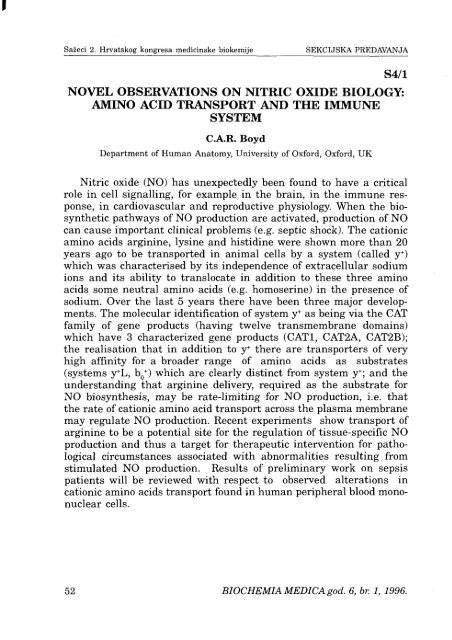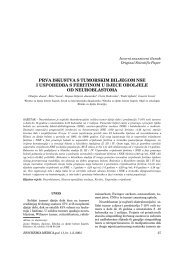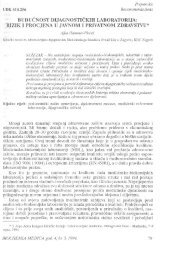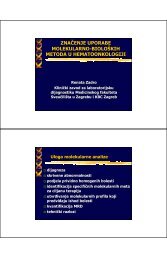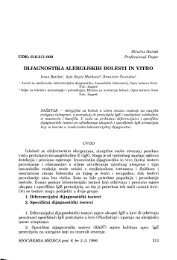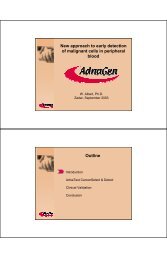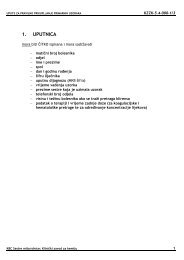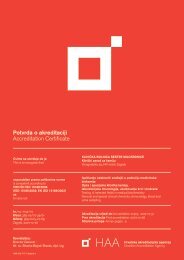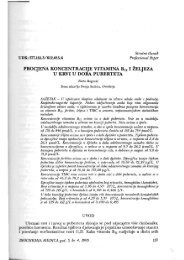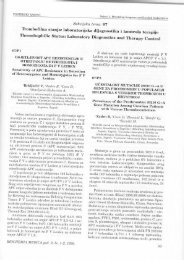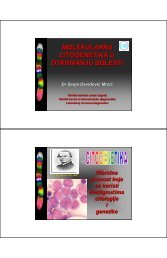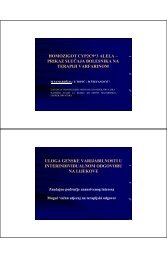Sažeci 2. Hrvatskog kongresa medicinske biokemije - Klinički zavod ...
Sažeci 2. Hrvatskog kongresa medicinske biokemije - Klinički zavod ...
Sažeci 2. Hrvatskog kongresa medicinske biokemije - Klinički zavod ...
You also want an ePaper? Increase the reach of your titles
YUMPU automatically turns print PDFs into web optimized ePapers that Google loves.
I<br />
<strong>Sažeci</strong> <strong>2.</strong> <strong>Hrvatskog</strong> <strong>kongresa</strong> <strong>medicinske</strong> <strong>biokemije</strong><br />
SEKCIJSKA PREDAVANJA<br />
S4/1<br />
NOVEL OBSERVATIONS ON NITRIC OXIDE BIOLOGY:<br />
AMINO ACID TRANSPORT AND THE IMMUNE<br />
SYSTEM<br />
C.A.R. Boyd<br />
Department of Human Anatomy, University of Oxford, Oxford, UK<br />
Nitric oxide (NO) has unexpectedly been found to have a critical<br />
role in cell signalling, for example in the brain, in the immune response,<br />
in cardiovascular and reproductive physiology. When the biosynthetic<br />
pathways of NO production are activated, production of NO<br />
can cause important clinical problems (e.g. septic shock). The cationic<br />
amino acids arginine, lysine and histidine were shown more than 20<br />
years ago to be transported in animal cells by a system (called y + )<br />
which was characterised by its independence of extracellular sodium<br />
ions and its ability to translocate in addition to these three amino<br />
acids some neutral amino acids (e.g. homoserine) in the presence of<br />
sodium. Over the last 5 years there have been three major developments.<br />
The molecular identification of system y + as being via the CAT<br />
family of gene products (having twelve transmembrane domains)<br />
which have 3 characterized gene products (CAT1, CAT2A, CAT2B);<br />
the realisation that in addition to y + there are transporters of very<br />
high affinity for a broader range of amino acids as substrates<br />
(systems y + L, b + 0 ) which are clearly distinct from system y + ; and the<br />
understanding that arginine delivery, required as the substrate for<br />
NO biosvnthesis, may be rate-limiting for NO production, i.e. that<br />
the rate of cationic amino acid transport across the plasma membrane<br />
may regulate NO production. Recent experiments show transport of<br />
arginine to be a potential site for the regulation of tissue-specific NO<br />
production and thus a target for therapeutic intervention for pathological<br />
circumstances associated with abnormalities resulting from<br />
stimulated NO production. Results of preliminary work on sepsis<br />
patients will be reviewed with respect to observed alterations in<br />
cationic amino acids transport found in human peripheral blood mononuclear<br />
cells.<br />
52 BIOCHEMIA MEDICA god. 6, br. 1, 1996.


